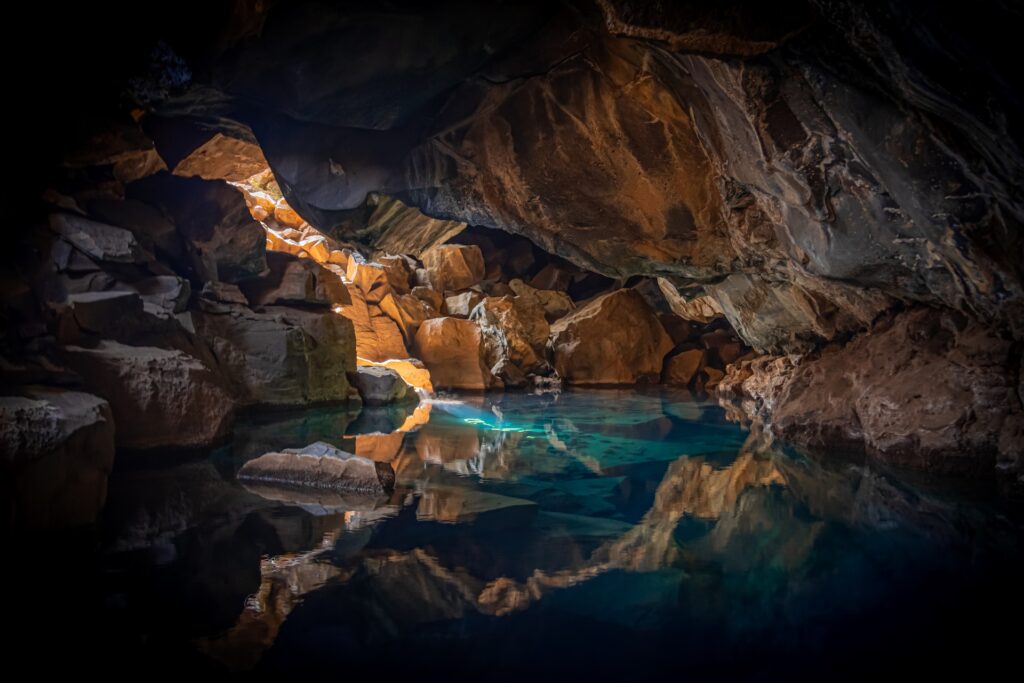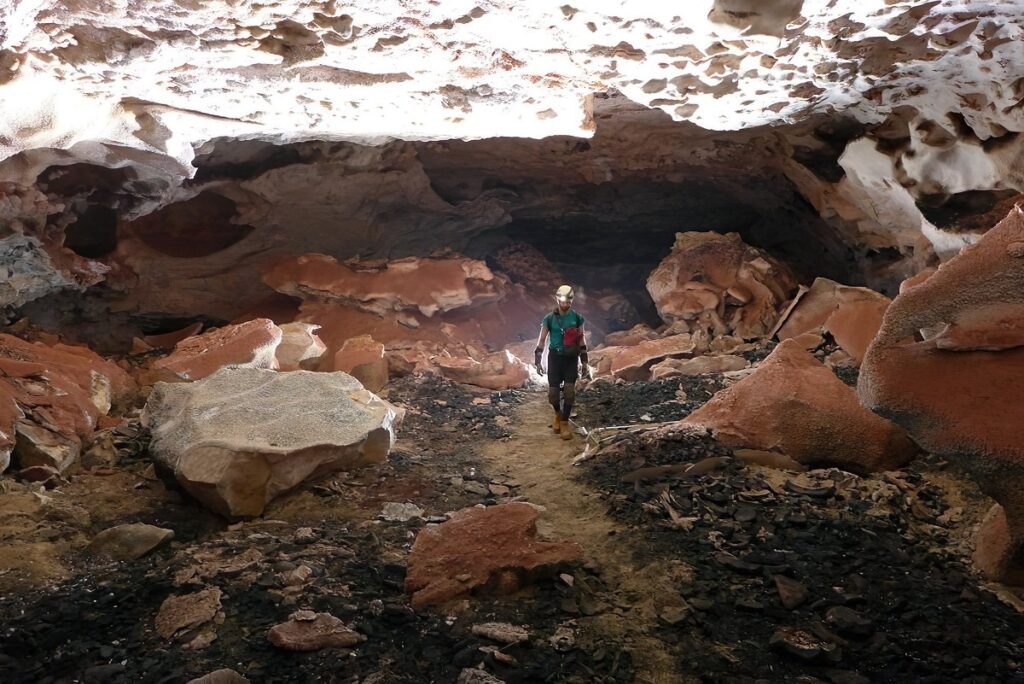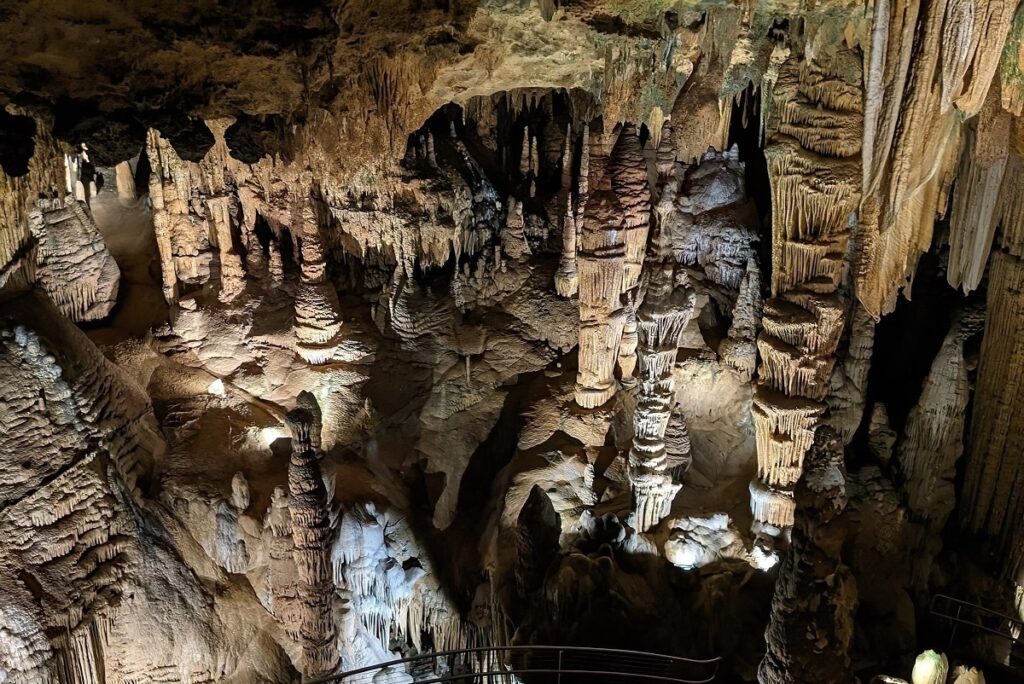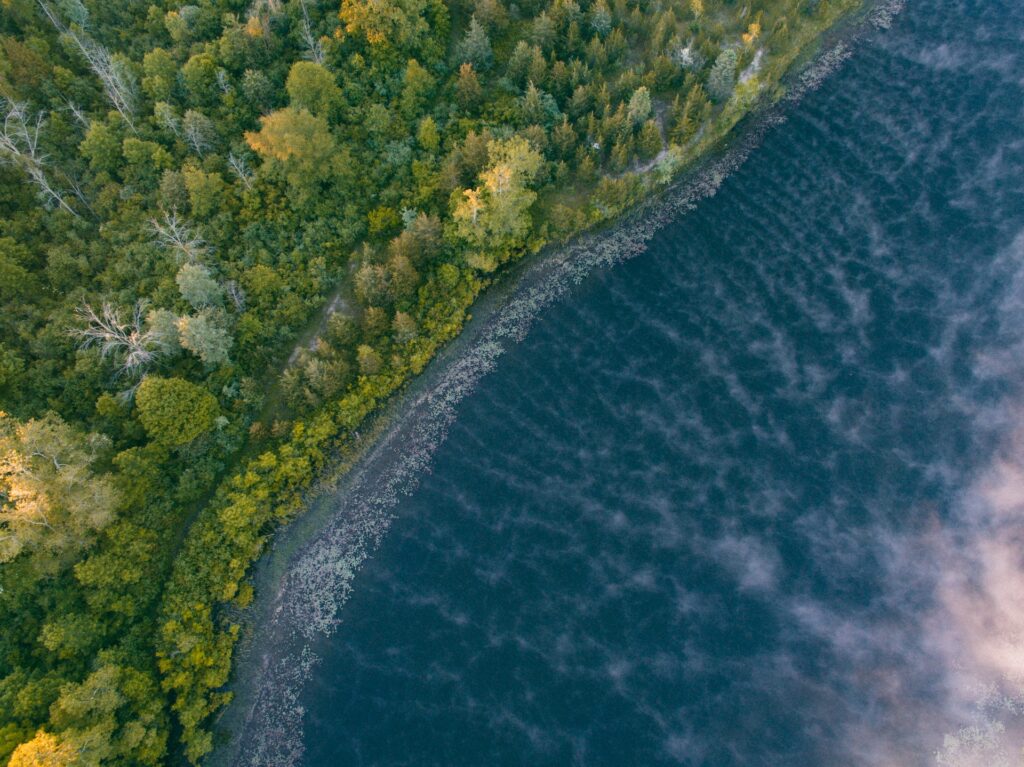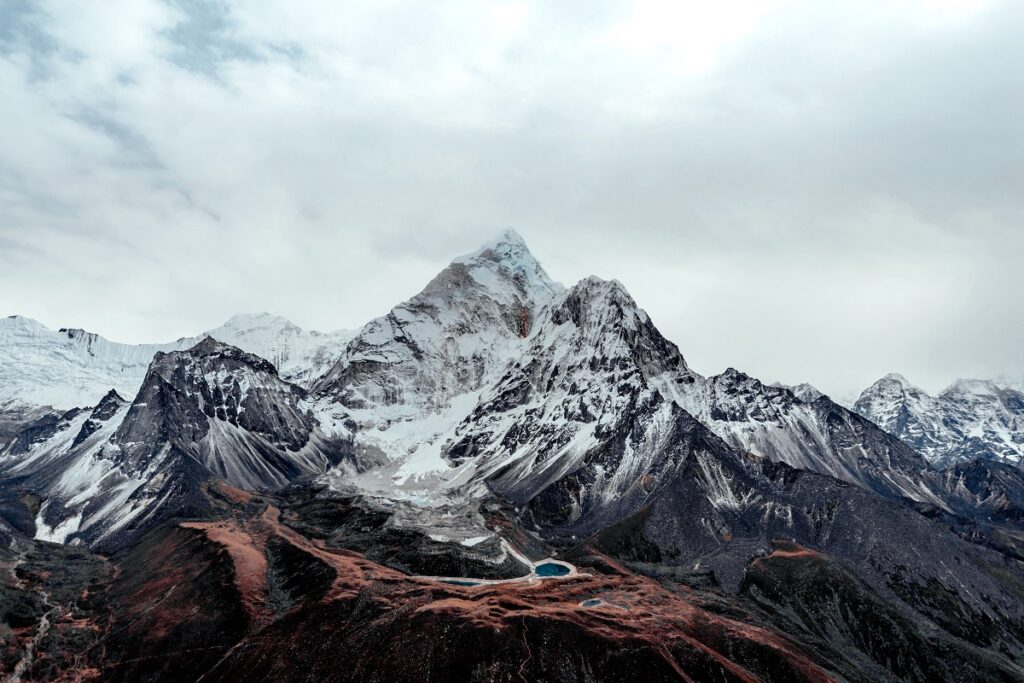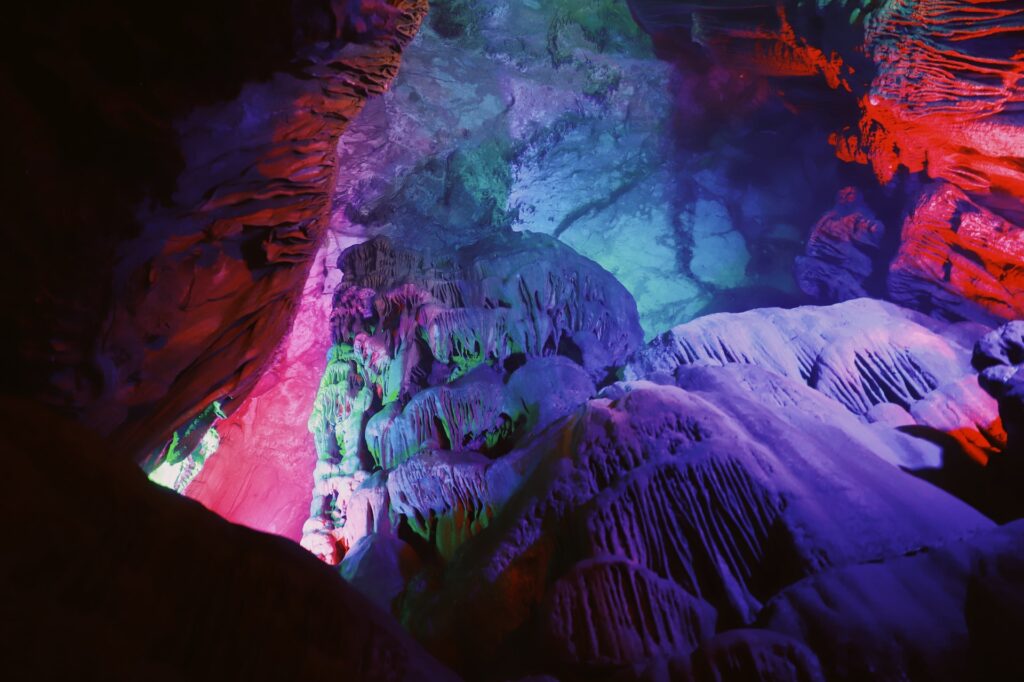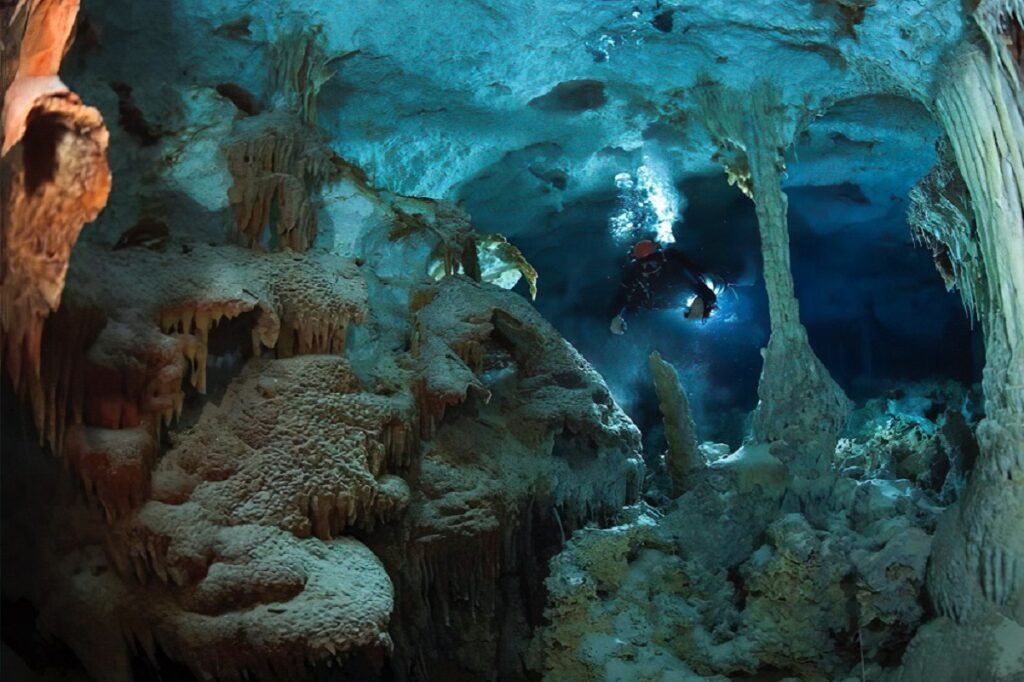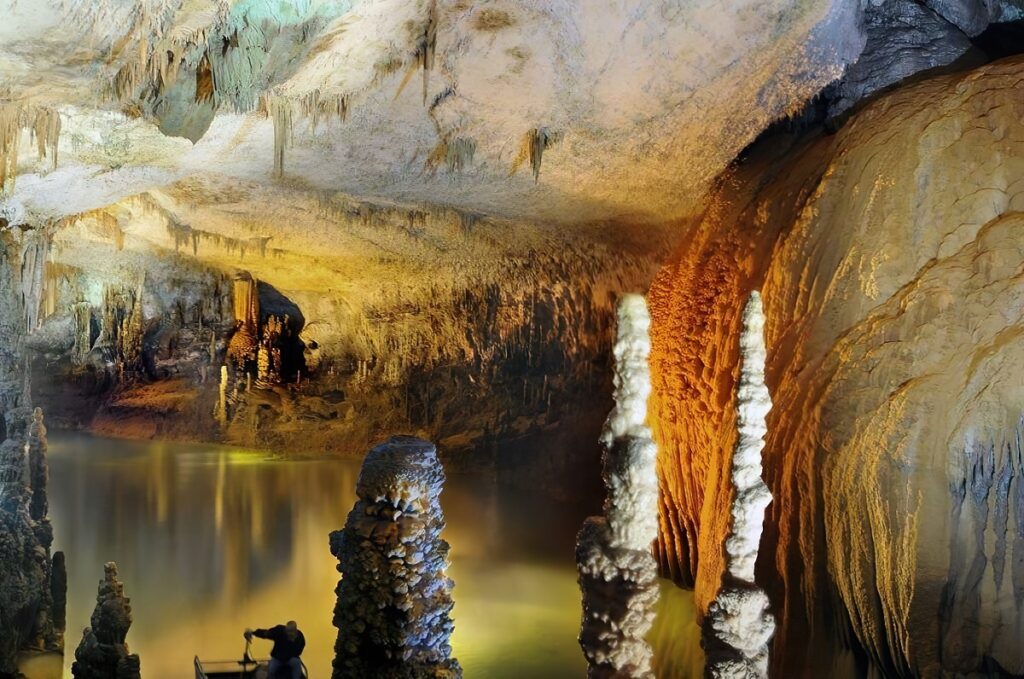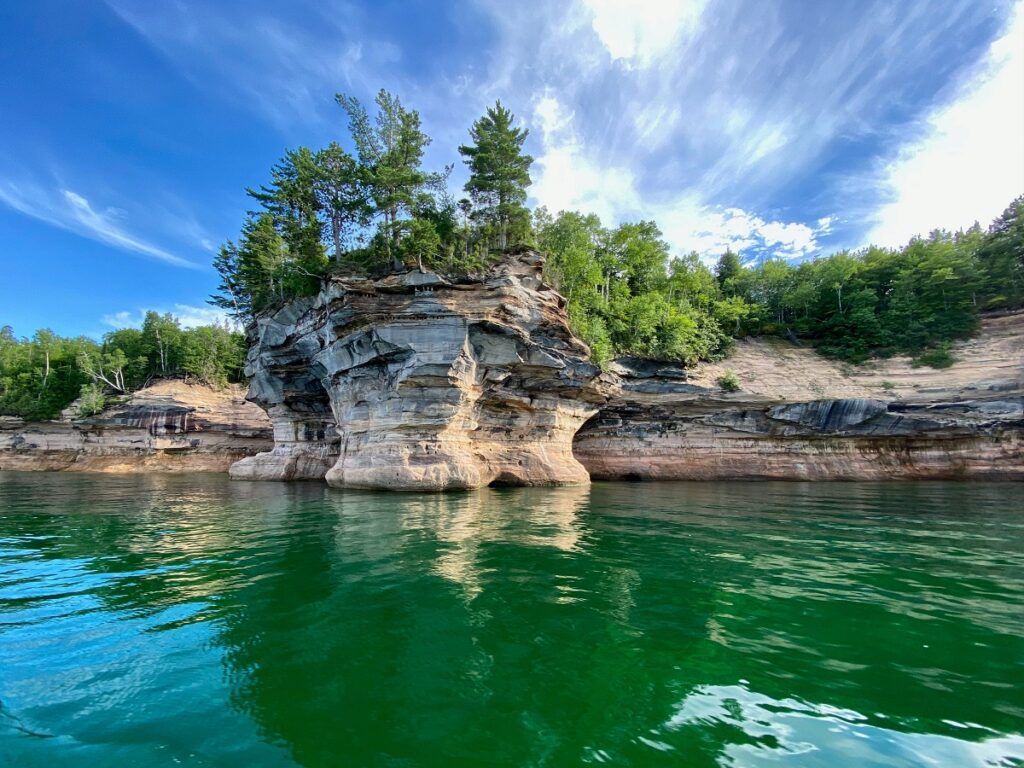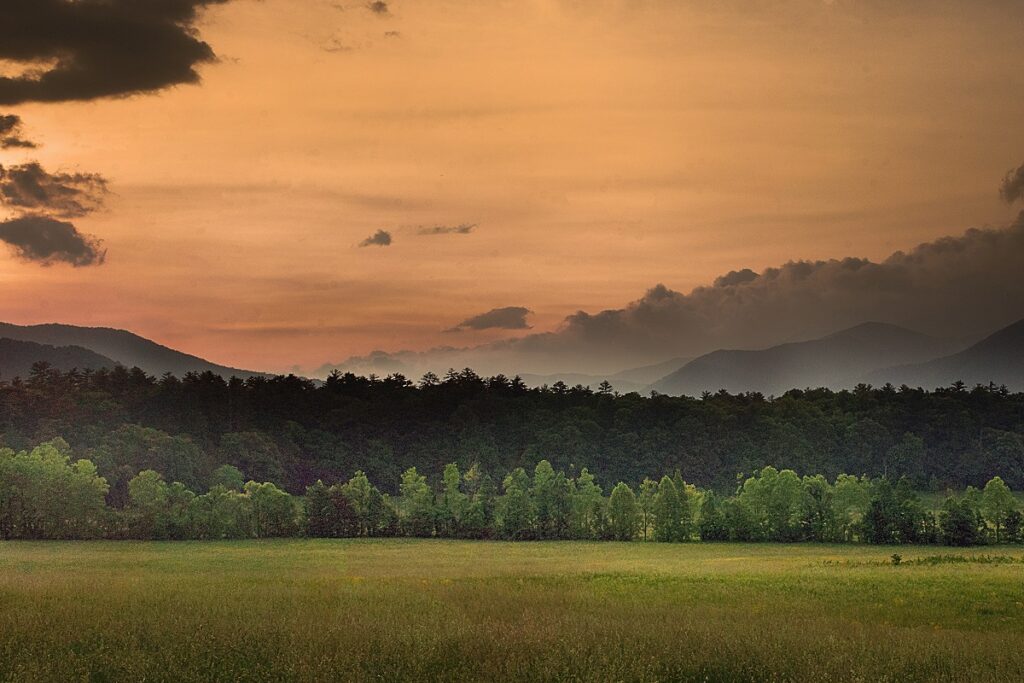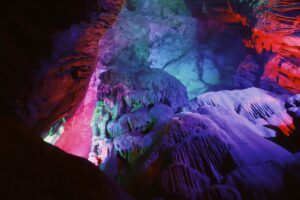Top 10 States with the Most Caves
Top 10 States with the Most Caves
WhiteClouds builds 3D Raised Relief Maps
Did you know we make
3D raised-relief maps
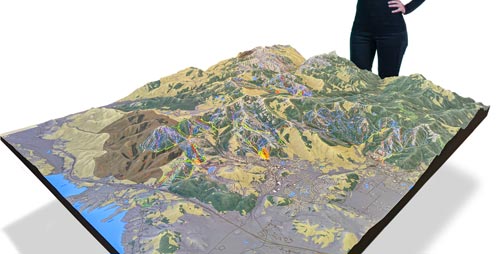
and
3D raised-relief maps

Adventure lies beneath our feet – the top 10 States with the Most Caves. The United States, known for its majestic mountains, expansive plains, and shimmering coastlines, hides a secret world of awe-inspiring beauty underground. Caves – geologic masterpieces carved by time, water, and pressure – captivate explorers and scientists alike with their enchanting formations and history-steeped caverns. Join us on a journey to the top 10 states teeming with the highest number of these natural underground cathedrals, coupled with captivating tales that make these states subterranean wonderlands.
#1: Tennessee Caves (10,000)
A world of wonder lies beneath our feet in Tennessee. This Southern state, known for its mesmerizing mountains, soulful music, and rich history, conceals thousands of natural wonders in the form of caves. An astonishing 10,000 caves wind their way through the limestone bedrock, earning Tennessee the nickname “The Underground State.” Let’s delve into this fascinating subterranean world, spotlighting three of the most unique caves that embody the state’s captivating geological story.
The Ruby Falls: An Underground Waterfall Illuminated
First, we visit Lookout Mountain, where the enchanting Ruby Falls have been captivating visitors since its discovery in 1928. Unique in its formation, this is an underground waterfall – yes, you read that correctly! Imagine a cascade of water free-falling 145 feet, illuminated to exhibit a dazzling ruby-red hue, all within the depths of a mountain. The discovery of Ruby Falls is a story of love. When Leo Lambert, a chemist and caving enthusiast, stumbled upon this wonder while exploring an opening to Lookout Mountain Cave, he was so moved that he named it after his wife, Ruby. Today, visitors can witness this subterranean spectacle, which remains the tallest and deepest underground waterfall open to the public in the United States. Ruby Falls epitomizes the romantic mystery of Tennessee’s underground world.
The Lost Sea: An Underwater Adventure
Next, we embark on a voyage to the Lost Sea, located in Craighead Caverns. This isn’t your average cave; it’s home to America’s largest underground lake. As you descend into the cool caverns, a glassy expanse of water emerges from the shadows, complete with an ecosystem of rare anthracite-colored Rainbow Trout. The Lost Sea has borne witness to a plethora of history, from Cherokee Indians who used the cave for storage to Confederate soldiers mining the cave for saltpeter – a component of gunpowder. This underwater wonderland tells a unique geological and historical tale that can’t be experienced anywhere else.
The Bell Witch Cave: A Haunting Tale
Finally, for those who enjoy a dash of eerie excitement, the Bell Witch Cave offers a chilling thrill. The cave, located in Adams, TN, is infamous for its association with the Bell Witch, a folk legend that has haunted the imaginations of Tennesseans for centuries. The legend tells of the Bell family, who in the early 19th century were tormented by a malicious entity, later known as the “Bell Witch.” This spectral figure is said to have resided within the cave on the Bell’s property. Whether you’re a believer in the supernatural or not, the Bell Witch Cave offers a unique blend of natural beauty, local folklore, and historical mystery that sets it apart.
#2: Missouri Caves (7,300)
Missouri, the “Show-Me State,” is aptly named when it comes to its impressive natural features. Renowned for its mighty rivers, beautiful prairies, and towering bluffs, Missouri harbors a treasure trove of geological wonders beneath its surface. The state is a caver’s paradise, home to over 7,300 caves that weave a fascinating underground tapestry. As we journey into the bowels of Missouri’s landscapes, let’s spotlight three of its most unique and breathtaking cave systems that will leave you awe-struck and yearning for an adventure of your own.
Meramec Caverns: The Outlaw’s Refuge
First on our list is the mighty Meramec Caverns, a seven-story natural wonder located in the Ozarks. This is no ordinary cave; it’s a canvas of geological art, brimming with awe-inspiring stalactites, stalagmites, and a rare formation called the “Wine Table.” However, it’s the Meramec Caverns’ historical significance that lends them a unique allure. The caverns served as a hideout for the notorious outlaw Jesse James and his gang. It’s said that the gang used the winding passageways to evade capture from lawmen, providing a safe haven for their nefarious activities. As you venture into this subterranean maze, you’re not just stepping into a cave – you’re stepping into a chapter of Missouri’s wild past.
Onondaga Cave: A National Natural Landmark
Missouri’s Onondaga Cave, a designated National Natural Landmark, is an underground wonderland that enchants its visitors with a dazzling display of speleothems – structures formed by mineral deposits. Here you’ll witness the “Twin Giants,” a pair of towering stalagmites, and the exquisite “Lily Pad Room,” where thin layers of calcite have created an array of delicate, lily pad-like formations across the pool surface. The Onondaga Cave is unique for its remarkable variety of well-preserved formations. The cave’s cool climate and the mineral-rich water seeping through the bedrock have resulted in an exceptional range of speleothem types and sizes. Every corner turned within the Onondaga Cave reveals a new, beautiful geological surprise.
Mark Twain Cave: A Literary Icon
Finally, the Mark Twain Cave holds a special place in the literary world. This labyrinthine cave was immortalized in Mark Twain’s classic novel, “The Adventures of Tom Sawyer.” As a child, Twain (then known as Samuel Clemens) lived in Hannibal, Missouri, where he explored the local caves that would later serve as the backdrop for his famous story. Visitors today can walk in the fictional footsteps of Tom Sawyer and Becky Thatcher, exploring the mysterious maze-like chambers and corridors. The Mark Twain Cave, brimming with history and folklore, adds a unique literary dimension to Missouri’s subterranean wonders.
#3: Alabama Caves (4,000)
Alabama, often celebrated for its sun-kissed Gulf Coast, verdant forests, and significant Civil Rights landmarks, houses an equally enchanting world beneath its surface. With over 4,000 recorded caves, the Heart of Dixie beckons spelunkers, historians, and curious adventurers to explore its impressive subterranean landscapes. Come along as we navigate the depths of Alabama’s diverse caves, spotlighting three of the state’s most unique caverns that echo the intrigue of this Southern gem.
Cathedral Caverns: The Grandeur Beneath
First on our underground journey is Cathedral Caverns, a magnificent cave system that will leave you in awe with its imposing entrance — a gaping 126-feet-wide and 25-feet-high mouth. Within, you’ll find “Goliath,” one of the world’s largest stalagmites, reaching a towering 45 feet with a 243-foot circumference. Cathedral Caverns earns its name from its cathedral-like grandeur, resonating a unique spiritual connection with nature. As you wander through this subterranean masterpiece, you will be mesmerized by the myriad formations that adorn this natural cathedral, echoing the hushed whispers of Earth’s ancient past.
Russell Cave: An Archeological Treasure
Next, we venture into Russell Cave, located in the northeastern corner of Alabama. This isn’t your typical cave exploration — it’s a journey through time. Russell Cave is an archeological site that has provided crucial insight into the lives of prehistoric peoples in the Southeast. With evidence of continuous human habitation dating back over 10,000 years, Russell Cave provides a unique window into the past. Artifacts such as arrowheads, pottery, and ancient hearths tell a tale of survival and adaptation in the prehistoric world. As you wander through the cave, you’ll be walking in the footsteps of the ancients, offering a unique and humbling connection to the past.
DeSoto Caverns: A Tapestry of History
Our last stop, DeSoto Caverns, wears many hats. Prehistoric site, confederate mining location, prohibition-era speakeasy, and now a family fun park — this cave is a tapestry woven with colorful threads of history.
But the cave is not just remarkable for its historical significance; it’s a geological marvel as well. The cavern houses an awe-inspiring collection of onyx-marble stalagmites and stalactites. The ceiling of the main room, also known as “The Big Room,” is encrusted with thousands of glittering formations, creating a star-like illusion.
#4: Kentucky Caves (3,000)
Kentucky, famous for its bluegrass fields, horse racing, and bourbon distilleries, has an equally compelling secret beneath its rolling landscapes. The Bluegrass State boasts a complex network of caves that delve deep into the heart of Kentucky’s limestone bedrock, making it a world-class destination for caving enthusiasts. Let’s journey underground to discover three of the most extraordinary caves that offer unique tales of Kentucky’s geological, historical, and biological richness.
Mammoth Cave: The World’s Longest Cave System
No exploration of Kentucky’s underground can begin without the mention of Mammoth Cave. This massive subterranean network is recognized as the longest cave system in the world, stretching more than 400 miles beneath the earth’s surface. A journey into Mammoth Cave feels like stepping into a Jules Verne novel. The vast labyrinth of passages, tunnels, and caverns evokes a sense of awe and wonder. The “Gothic Avenue” section, so named for the signatures written on the ceiling with candle smoke, adds an unusual human touch to this natural marvel. But the true uniqueness of Mammoth Cave lies in its geological diversity, displaying every type of cave formation and a variety of minerals.
Crystal Onyx Cave: A Subterranean Gem
Next, we journey to Crystal Onyx Cave, a true gem that sparkles in Kentucky’s underground crown. As its name suggests, the cave is home to beautiful formations of flowstone, stalactites, and stalagmites, which have crystallized over time into brilliant onyx. Crystal Onyx Cave is also an archaeological treasure trove, housing ancient remains from Native Americans who took shelter here thousands of years ago. The cave truly embodies a blend of geological splendor and rich cultural history, adding a unique layer to Kentucky’s underground allure.
Hidden River Cave: An Underground River’s Tale
Finally, we visit Hidden River Cave, a subterranean marvel named for the river that runs through it. This underground river’s unique ecosystem houses eyeless creatures that have adapted to life in total darkness, providing a fascinating insight into the power of adaptation. The history of Hidden River Cave is equally intriguing, having gone from a significant water source to a pollution-ridden dumping site, and then revived into a celebrated show cave and museum. It’s a tale of ecological resurrection, symbolizing hope and restoration.
#5: Indiana Caves (2,500)
Indiana, famous for its diverse landscapes, from the sandy dunes of Lake Michigan to the rolling hills of its southern reaches, also houses a rich tapestry of geological splendor beneath its surface. This Hoosier State is home to some impressive caves, each with its own unique story and dazzling features. We’ll guide you through three of Indiana’s most remarkable caves that echo tales of geological marvels, fascinating ecosystems, and historical intrigue.
Wyandotte Caves: A Geologist’s Dream
First on our subterranean exploration is Wyandotte Caves, located in Crawford County. It’s a geological paradise, featuring spectacular cave formations, including the world’s largest onyx stalactite known as “The Pillar of the Constitution.” The cave also boasts a notable collection of helictites — irregular stalactites that grow in all directions — resulting in a mesmerizing display of nature’s craftsmanship. But the uniqueness of Wyandotte Caves doesn’t end at its remarkable structures. It’s also a refuge for Indiana bats, offering visitors a chance to observe these fascinating creatures in their natural habitat, making it an indispensable destination for eco-tourism in Indiana.
Bluespring Caverns: A Voyage in the Dark
Next on our tour is Bluespring Caverns, a network of subterranean waterways that takes visitors on a unique boat journey through the longest navigable underground river in the U.S. Drifting through the winding waterways, you’ll observe a stunning array of cave formations highlighted by the eerie glow of your boat’s light. What sets Bluespring Caverns apart is not only its aquatic journey but also its blind and albino fauna. The cave is home to blind crawfish and albino amphibians, offering a fascinating look into how species adapt to extreme conditions. It’s an adventure that promises a touch of the mysterious and a hefty dose of awe-inspiring natural beauty.
Squire Boone Caverns: A Historical Journey Underground
Our final destination, Squire Boone Caverns, offers a unique blend of history, adventure, and geology. Named after Squire Boone, the younger brother of the famous American pioneer Daniel Boone, the caverns boast winding passageways filled with stunning stalactites, stalagmites, and flowstone deposits. The Squire Boone Caverns are not just geologically unique but historically significant too. They served as a hiding place for Squire Boone during his skirmishes with the local native tribes in the late 18th century. Adding to its intrigue, the caverns are the final resting place of Squire Boone, whose remains lie within the caves. Visitors today can immerse themselves in this captivating blend of history and geology, walking the same paths as this historical figure once did.
#6: Virginia Caves (2,000)
Virginia, celebrated for its historical landmarks, sweeping mountains, and sprawling coastlines, also harbors a fascinating world beneath its picturesque landscapes. The Old Dominion is home to over 4,000 caves, each teeming with geological wonders, vibrant ecosystems, and rich history. Let’s journey below ground to explore three of Virginia’s most extraordinary caves that highlight the state’s intriguing underground marvels.
Luray Caverns: An Underground Symphony
Our first stop is the breathtaking Luray Caverns, the most extensive cavern system in the Eastern U.S. Renowned for its stunning stalactite and stalagmite formations, Luray Caverns will captivate you with its “Giant’s Hall,” a colossal chamber adorned with towering stone columns. However, Luray’s unique attraction is its Stalacpipe Organ, the world’s largest musical instrument. This organ gently taps stalactites throughout the caverns to produce hauntingly beautiful music. The result is a surreal blend of nature and human ingenuity, turning a visit to Luray Caverns into a melodious adventure that echoes through the ages.
Endless Caverns: A Geologist’s Canvas
Next, we delve into the Endless Caverns, a series of chambers and passageways whose beauty and expansiveness give it its name. With stunning displays of draperies, flowstones, and columns, it’s a testament to thousands of years of patient geological craftsmanship. The uniqueness of Endless Caverns comes from its colored formations. Due to the presence of different minerals, the formations come alive with shades of red, orange, and brown, providing a vibrant contrast to the cave’s natural grey background. It’s a mesmerizing spectacle of nature’s artistry, offering a spectacle that is truly out of this world.
Gap Caverns: A Step Back in Time
Lastly, we journey through time at Gap Caverns, a cave system that unveils the history of Virginia in layers of limestone. As visitors descend into the cave, they traverse through 200 million years of geological history, from the stalactite-filled Dome Room to the mysterious “Pulpit Rock.” Gap Caverns is unique for its living history. It served as a vital saltpeter source during the Civil War and bears the marks of these mining efforts. As visitors walk through the cavern, they are not only exploring an ecological marvel but also a historical site that played a significant role in shaping Virginia’s history.
#7: West Virginia Caves (1,500)
West Virginia, known for its verdant mountains, meandering rivers, and rich history, conceals a breathtaking world beneath its surface. The Mountain State is home to hundreds of caves, each featuring a distinct blend of geological formations, vibrant ecosystems, and fascinating folklore. Let’s descend into the depths of West Virginia’s subterranean treasures and unearth the stories of three of the state’s most extraordinary caves.
Organ Cave: A Symphony in Stone
Our first stop is the majestic Organ Cave, the second longest cave on the east coast of the United States. This vast cavern, filled with magnificent stalactite and stalagmite formations, will leave you spellbound with its “Theatre Room,” a grand chamber adorned with formations resembling a colossal pipe organ. Organ Cave, however, holds more than just geological marvels. It served as a vital source of saltpeter during the Civil War, leaving behind mining artifacts that bear witness to this historical era. This intertwining of natural beauty and human history lends Organ Cave a unique character, creating an experience that resonates with the echoes of the past amidst the backdrop of timeless geological grandeur.
Seneca Caverns: The Deepest Experience in the Appalachians
Next, we delve into the depths of Seneca Caverns, a stunning labyrinth of underground chambers and passageways. With its awe-inspiring formations, including the towering Sentinel Room filled with colossal stalactites and stalagmites, it’s an ode to the artistry of nature crafted over millions of years. Seneca Caverns’ uniqueness lies in its natural history. Its limestone bedrock cradles fossils of marine life from the ancient seas that once covered West Virginia, providing a window into a long-lost era. It’s an unforgettable journey into the geologic past that truly lives up to its claim of being the ‘Deepest Experience in the Appalachians.’
Smoke Hole Caverns: A Story Carved in Stone
Finally, we explore Smoke Hole Caverns, a cave system known for its historical allure and stunning underground lake. As you navigate through the cave, you’ll be captivated by formations like the “Room of a Million Stalactites” and the mesmerizing reflections in the crystal-clear lake. Smoke Hole Caverns has a rich history. Local lore tells of Native Americans using the cave for smoking meats, hence its name, and tales of moonshiners during Prohibition add to its mystique. The cave’s blend of stunning natural formations and intriguing history makes it a one-of-a-kind subterranean adventure.
#8: Georgia Caves (1,000)
Georgia, celebrated for its charming Southern hospitality, iconic peaches, and sprawling mountain ranges, also conceals an awe-inspiring world beneath its diverse landscapes. The Peach State is home to a myriad of caves, each resounding with tales of stunning geological structures, unique ecosystems, and intriguing history. Let’s embark on a journey below the surface to explore three of Georgia’s most extraordinary caves, each carrying their unique allure.
Ellison’s Cave: A Vertical Wonder
Our first descent is into the depths of Ellison’s Cave, the 12th longest cave in the United States and the deepest in the country. What truly sets Ellison’s Cave apart is its verticality, home to two of the deepest pits in the United States: the “Fantastic Pit,” dropping an incredible 586 feet, and the “Incredible Pit,” plunging another 440 feet. Descending into these pits is not for the faint of heart, requiring specialized caving equipment and experience, but the reward is a chance to observe jaw-dropping cave formations in an environment that few dare to venture into. Ellison’s Cave is a thrilling challenge for experienced cavers, making it a unique destination for underground exploration in Georgia.
Sitton’s Cave: A Walkable Wonder
Next, we venture into the more accessible Sitton’s Cave. It’s a stream cave, meaning that it was carved out over thousands of years by the action of flowing water. The cave’s uniqueness lies in its walkability and the ‘cool’ experience it provides: The temperature inside the cave stays around 58 degrees Fahrenheit year-round, offering a refreshing retreat from Georgia’s heat. Visitors to Sitton’s Cave will encounter mesmerizing formations of stalactites and stalagmites, a burbling creek that echoes through the chambers, and even a small waterfall. It’s a subterranean trek that showcases the beauty and the power of nature’s slow, persistent force of creation.
Frick’s Cave: A Protected Haven
Finally, we highlight Frick’s Cave, which is unique for an entirely different reason. This cave, the second-longest in Georgia, is closed to the general public. The reason? It’s a significant wintering habitat for the endangered gray bat and the home to several other rare and protected species. Frick’s Cave exemplifies the importance of conservation, with the Southeastern Cave Conservancy taking meticulous care to protect its fragile inhabitants. Although general access is restricted, the cave is opened for a guided tour once a year, providing a glimpse into this exclusive habitat.
#9: Arkansas Caves (1,000)
Arkansas, lauded for its enchanting landscapes, pristine lakes, and sprawling mountains, also harbors a captivating world beneath its scenic vistas. The Natural State is home to a plethora of caves, each echoing with fascinating tales of stunning geological structures, peculiar ecosystems, and intriguing history. Let’s explore below ground level and unveil three of Arkansas’s most extraordinary caves that showcase the state’s distinct subterranean beauty.
Blanchard Springs Caverns: A Living Cave
Our first stop is the mesmerizing Blanchard Springs Caverns, a “living” cave system in the heart of the Ozark National Forest. What sets Blanchard Springs apart is its active status, as mineral-rich water continues to painstakingly create enchanting formations of stalactites, stalagmites, flowstones, and draperies. The caverns offer visitors a tour of multiple levels, each showcasing diverse formations. From the crystalline beauty of the “Titanic Room” to the underground river flowing in the depths of the cave, Blanchard Springs encapsulates the artistry of nature in its purest form, making it an unmissable stop for any cave enthusiast.
Cosmic Cavern: Arkansas’s Underground Treasure
Next, we dive into the Cosmic Cavern, one of Arkansas’s hidden treasures. The cave is known for its warm and inviting temperature, keeping at a cozy 64 degrees Fahrenheit year-round, but what truly sets it apart are its two bottomless lakes. One of these lakes boasts the intriguingly named “Silent Splendor,” an array of delicate, soda-straw formations considered one of the longest in the world. Notably, these formations remained undiscovered until as recently as 1993, proving that the depths of the Cosmic Cavern still have secrets to reveal.
Old Spanish Treasure Cave: A Historical Mystery
Finally, we journey into the Old Spanish Treasure Cave, a cavern enveloped in mystery and tales of hidden treasure. Legend has it that Spanish Conquistadors, fleeing from native tribes, hid a treasure trove within this cave in the 17th century. The treasure remains undiscovered, adding an air of intrigue to every visit. Besides its enticing lore, the cave offers a wealth of geological beauty. With its impressive formations and a guided tour featuring the “Room of a Thousand Faces” and the “Council Room,” the Old Spanish Treasure Cave offers a unique blend of mystery, history, and natural splendor.
#10: Pennsylvania Caves (800)
Pennsylvania, known for its historical landmarks, picturesque landscapes, and charming small towns, also conceals an alluring world beneath its terrain. The Keystone State is home to hundreds of caves, each resounding with tales of stunning geological formations, unique ecosystems, and rich history. Let’s take a fascinating journey below ground level to explore three of Pennsylvania’s most extraordinary caves.
Penn’s Cave: An Aquatic Adventure
Our first descent is into the depths of Penn’s Cave, the only all-water cavern in the United States. This unique cave takes visitors on a motorboat tour through its winding passageways, providing a rare opportunity to experience a cave system from an entirely different perspective. But what sets Penn’s Cave apart is its historical and cultural significance. Native American legend speaks of a tragic love story between a French trapper and a Seneca princess that took place here, adding a layer of mystique and folklore to the beautiful limestone formations and cool, dark waters.
Laurel Caverns: A Geological Wonderland
Next, we navigate through Laurel Caverns, Pennsylvania’s largest cave. Situated in the state’s southwestern corner, Laurel Caverns is a vast, sandstone cavern known for its extraordinary geological features, including fluted ceilings and honeycomb-like structures. However, the standout feature of Laurel Caverns is its versatility. It offers everything from traditional guided tours to more adventurous options like spelunking and rappelling. The cave’s layout changes seasonally due to the shifting sands, making each visit a unique exploration and earning it a place among the Keystone State’s most intriguing natural attractions.
Indian Echo Caverns: A Portal to the Past
Finally, we journey into the fascinating Indian Echo Caverns, a limestone cavern known for its stunning stalactite and stalagmite formations. However, the cave’s allure extends beyond its natural beauty. It’s also a significant historical site, believed to have been used by the Susquehannock Indians as a refuge from the elements and other tribes. Indian Echo Caverns provides a rare glimpse into the lives of those who sought shelter here centuries ago. With tales of a hermit who lived and died in the caverns, and the echo phenomenon giving the caverns their name, a visit to Indian Echo Caverns becomes a historical exploration imbued with a sense of wonder and curiosity.
These top 10 states reveal the United States’ hidden geological grandeur beneath the surface. Each cave is a portal to an age-old world, showcasing breathtaking formations, harboring unique ecosystems, and often whispering tales of human history. As we continue to unearth these subterranean secrets, we’re reminded of the immense diversity and beauty of our natural world, both above ground and beneath it.
More Great Top 10’s
Caves and Maps
A glimpse into the deep recesses of the earth, caves present a fascinating blend of history, geology, and biodiversity, making them intriguing subjects for exploration and study. Yet, this subterranean world can be perilous, filled with a labyrinth of passages, some of which stretch for miles. Understanding the spatial intricacies of caves is paramount for safe and successful exploration. Here is where maps come into play. The relationship between caves and maps is as profound as it is practical, offering a unique intersection of science, exploration, and cartography.
Mapping caves, or speleology, is a critical aspect of caving. It aids researchers and explorers in understanding the complex networks below the earth’s surface, helps guide rescue operations, informs conservation efforts, and contributes to our knowledge of earth’s history.
In essence, the relationship between caves and maps is an intricate dance between exploration and understanding. Cave maps not only guide us safely through the earth’s subterranean labyrinths but also help us understand these mysterious structures better, aiding scientific research, contributing to effective conservation, and enhancing the thrill of exploration.
Learn more about Maps
- Topographical Maps: Representation of the physical features of a region or area.
- Contour Maps: Representation of the contours of the land surface or ocean floor.
- Raised Relief Maps: Representation of land elevations with raised features indicating landforms.
- Terrain Maps: Representation of the physical features of a terrain or landmass.
- USGS Topographic Maps: Representation of topographic features and land elevations based on USGS data.
- USGS Historical Topographic Maps: Representation of historical topographic maps created by the USGS.
- Watershed Maps: Representation of the areas where water flows into a particular river or lake.
- Elevation Maps: Representation of land and water elevations with high precision.
- Physical Maps: Representation of physical features of the Earth’s surface such as landforms, oceans, and plateaus.
- Bathymetric Maps: Representation of the topography and features of the ocean floor.
- NOAA Maps: Representation of atmospheric, oceanographic, and environmental data by NOAA.
- Nautical Maps: Representation of the underwater features and depth of an area for navigation purposes.
- Geologic Maps: Representation of the geologic features of an area such as rock types, faults, and folds.
- Satellite Maps: Representation of earth from high-definition satellite imagery.
Contact us today to learn more about our services and how we can help you achieve your goals.
